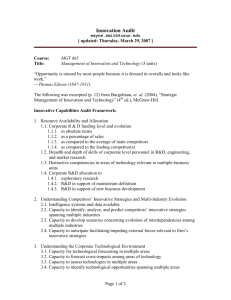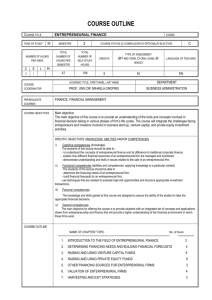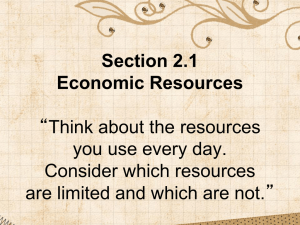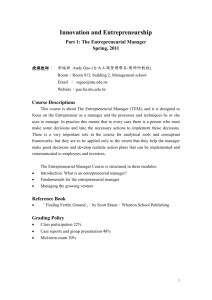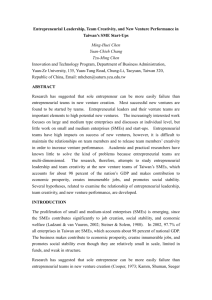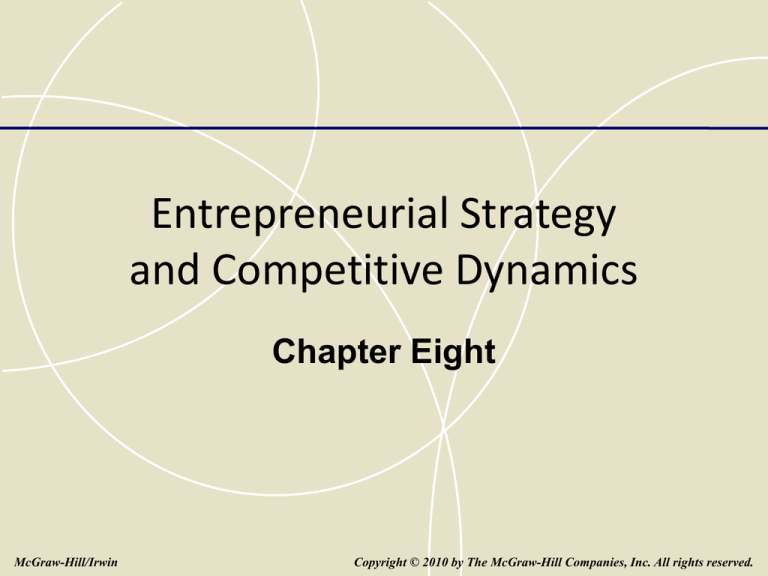
Entrepreneurial Strategy
and Competitive Dynamics
Chapter Eight
McGraw-Hill/Irwin
Copyright © 2010 by The McGraw-Hill Companies, Inc. All rights reserved.
Recognizing Entrepreneurial
Opportunities
• Entrepreneurship
the creation of new value by an existing
organization or new venture that involves the
assumption of risk.
8-2
Recognizing Entrepreneurial
Opportunities
• New value can be created in:
Start-up ventures
Major corporations
Family-owned businesses
Non-profit organizations
Established institutions
8-3
U.S. Small Companies by Industry
8-4
Entrepreneurial Opportunities
• Opportunity recognition
the process of discovering and evaluating
changes in the business environment, such
as a new technology, socio-cultural trends, or
shifts in consumer demand, that can be
exploited.
8-5
Opportunity Analysis Framework
8-6
QUESTION
The majority of entrepreneurial start-ups are
financed with
A. Bank financing
B. Public financing
C. Venture capital financing
D. Personal savings and the contributions
of family and friends
8-7
Entrepreneurial Opportunities
•
•
•
•
•
Start-ups
Current or past work experiences
Hobbies that grow into businesses or lead
to inventions
Suggestions by friends or family
Chance events
Change
8-8
Entrepreneurial Opportunities
•
•
•
•
Established firms
Needs of existing customers
Suggestions by suppliers
Technological developments that lead to
new advances
Change
8-9
Entrepreneurial Opportunities
• Discovery phase
the process of becoming aware of a new
business concept.
May be spontaneous and unexpected
May occur as the result of deliberate search
for new venture projects or creative solutions
to business problems
8-10
Opportunity Recognition Process
• Opportunity evaluation phase
involves analyzing an opportunity to
determine whether it is viable and strong
enough to be developed into a full-fledged
new venture.
• Talk to potential target customers
• Discuss it with production or logistics managers
• Conduct feasibility analysis
8-11
Characteristics of Good Opportunities
•
•
•
•
Attractive
Achievable
Durable
Value creating
8-12
Financial Resources
• The types of financial resources that may
be needed depend on two factors: the
stage of venture development and the
scale of the venture.
• To obtain funding for rapid growth, firms
often seek venture capital.
8-13
Financing New Ventures
8-14
Entrepreneurial Resources
• Human capital
• Social capital
• Government resources
Small Business Administration
Government contracting
State and local governments
8-15
Entrepreneurial Leadership
• Launching a new venture requires a
special kind of leadership
Courage
Belief in one’s convictions
Energy to work hard
8-16
Entrepreneurial Leadership
• Vision may be entrepreneur’s most
important asset
Ability to envision realities that do not yet
exist
Exercise a kind of transformational
leadership
Able to share with others
8-17
Entrepreneurial Leadership
• Dedication and drive are reflected in hard
work
Patience
Stamina
Willingness to work long hours
Internal motivation
Intellectual commitment to the enterprise
Strong enthusiasm for work and life
8-18
Entrepreneurial Leadership
• To achieve excellence, venture founders
and small business owners must
Understand the customer
Provide quality products and services
Pay attention to details
Continuously learn
Surround themselves with good people
8-19
Entrepreneurial Strategy
• Best strategy for the enterprise will be
determined to some extent by
A viable opportunity, resources, and skilled
and dedicated entrepreneurial team
Other conditions in the business environment
8-20
Entry Strategies
• Pioneering new entry
a firm’s entry into an industry
with a radical new product or
highly innovative service that
changes the way business is
conducted.
8-21
Entry Strategies
• Imitative new entry
a firm’s entry into an industry with products or
services that capitalize on proven market
successes and that usually has a strong
marketing orientation.
8-22
Entry Strategies
• Adaptive new entry
a firm’s entry into an industry by offering a
product or service that is somewhat new and
sufficiently different to create value for
customers by capitalizing on current market
trends.
8-23
Examples of Adaptive New Entrants
8-24
Elements of a Blue Ocean Strategy
•
•
•
•
•
Create uncontested market space
Make the competition irrelevant
Create and capture new demand
Break the value/cost tradeoff
Pursue differentiation and low cost
simultaneously.
8-25
Generic Strategies
• Overall cost leadership
Simple organizational structures
More quickly upgrade technology and
integrate feedback from the marketplace
Make timely decisions
that affect cost
8-26
Generic Strategies
• Differentiation
Use new technology
Deploy resources in a radical new way
• Focus
Niche strategies fit the small business mold
8-27
Combination Strategies
• Entrepreneurial firms are often in a strong
position to offer a combination strategy
Combine best features of low-cost,
differentiation, and focus strategies
Flexibility and quick decision-making ability of
a small firm not laden with layers of
bureaucracy
8-28
Competitive Dynamics
• Competitive dynamics
Intense rivalry, involving actions and
responses, among similar competitors vying
for the same customers in a marketplace.
8-29
Why Do Companies Launch New
Competitive Actions?
•
•
•
•
•
Improve market position
Capitalize on growing demand
Expand production capacity
Provide an innovative new solution
Obtain first mover advantages
8-30
Threat Analysis
• Threat analysis
A firm’s awareness of its closest competitors
and the kinds of competitive actions they
might be planning.
• Market commonality
• Resource similarity
8-31
Question
Aircraft makers Boeing and Airbus have a high
degree of __________ because they make very
similar products and have many buyers in
common.
A. Dynamic capabilities
B. Market commonality
C. First mover advantages
D. Equity funding
8-32
Five “Hardball” Strategies
•
•
•
•
•
Devastate rivals’ profit sanctuaries
Plagiarize with pride
Deceive the competition
Unleash massive and overwhelming force
Raise competitors’ costs
8-33
Strategic and
Tactical
Competitive
Actions
8-34
Likelihood of Competitive Reaction
• How a competitor is likely to respond will
depend on three factors
Market dependence
Competitor’s resources
The reputation of the firm that initiates the
action (actor’s reputation)
8-35
Choosing Not to React
• Forbearance
a firm’s choice of not
reacting to a rival’s
new competitive
action.
• Co-opetition
A firm’s strategy of
both cooperating and
competing with rival
firms.
8-36


